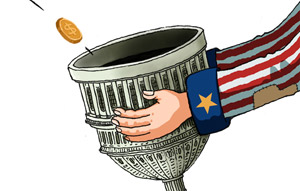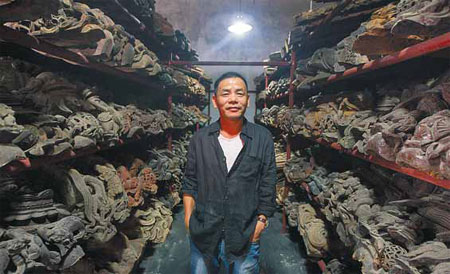Second time around
Updated: 2013-10-17 07:13
By Xu Junqian (China Daily)
|
||||||||
Old houses and classic Chinese furniture get a new lease on life as an eager collector is turning his passion into luxury resorts, Xu Junqian reports in Shanghai.
It's sheer understatement to say Qin Tongqian is a collector of century-old houses.
What the 50-year-old businessman has been collecting for more than half of his life bears an uncanny resemblance to Lego, the twice-named "toy of the century", except that the world of his collections is a real one.
His three warehouses, scattered in the suburbs of Shanghai and neighboring cities, are like gigantic walk-in closets, in which quaint Chinese-style wood doors, windows, pillars and all kinds of furniture are neatly separated by genres and fill each room to the brim.
A single piece from the staggering collection could easily excite historians, scholars and antique collectors in the country and probably command a good price if sold, say, millions of yuan for a bed. But for Qin, a high-school graduate who made his windfall by contracting garden work since the 1980s for expats in Shanghai, "these pastime gadgets" simply make him "comfortable".
"Women love clothes and shoes, some men love sports and cars. I happen to have a penchant for the old stuff," says Qin, standing in one of his warehouses, an abandoned military base in Shaoxing, Zhejiang province, the hometown of the self- dubbed "collecting maniac".
His penchant began in 1988, when he came across a set of traditional Chinese furniture in the home of a foreigner, one of his clients. At the time, people were busy replacing their decade- or even century-old furniture with brand-new Western pieces as the reform and open-up policy brought a new world to the country.
"It was like a cultural crush, reminding me how beautiful they are", as he put it.
So starting from a set of eight windows from the Qing Dynasty (1644-1911), Qin's collecting has been "unstoppable". He'll fall in love with a chair, and then bring back a whole set of furniture. Going for a door, he'll snap up the whole house.
Qin says he cannot remember how much money he's has invested or how many items are in his collection. A rough estimate would be tens of thousands of furniture pieces, hundreds of vases, paintings, calligraphy works and, most amazing, more than 200 old houses, dismantled as pieces in warehouses. Most are works of Ming (1368-1644) and Qing dynasties. And he has never sold a single piece.
No rules have been set by Qin when recycling such "trash disliked by countrymen", especially during the early years of his collection. He has hired a team of about 10 people to regularly "go deep into the countryside" to search for "treasures" for him and 200 or so carpenters to repair the houses and furniture for him.
Replicas have been rampant, as Qin admits, especially since the 1990s, and many have eyed the potential market. But he is barely discouraged.
"I have gotten more shrewd every time I was taken in. On the other hand," he says, "I avoided the most dangerous section, the market of china and vases."
Collecting becomes harder as the market gets ever more crowded, and the government has introduced a series of policies banning the sales of old houses, labeling them as cultural heritages. Qin hasn't bought a house since 2005.
But his collection lies less in numbers and price tags than in its cultural values.
According to Ruan Yisan, professor of urban planning at Shanghai's Tongji University and an ardent advocate of historic-building protection, the preservation of these antique houses is not only about saving a few beautifully carved pillars, corbels, beams and windows from the merciless wrecker's ball. It's also critical to preserve the way our ancestors lived and the relationship between family members.
"Perhaps many think that old is ugly. But I don't. I love mixing the old and new, putting a patch on a crack of the houses. Why does it have to be the same whitewashed new houses? Diversity is beautiful, like the different four seasons," Qin says.
After proudly furnishing his home, offices and private clubs with his "pastime gadgets", however, the businessman started to look for new ways, or spaces, to display his overrun stocks.
As a result, he built himself a "theme park", a Legoland-like place for "antique-aholics like him to sleep, eat and spend the time in the way one's ancestors did", even for just one day.
Occupying a space of 197,000 square meters against a pristine mountain as a former tea garden on the outskirts of Shaoxing, the park, Ahn Luh Lanting, a cooperation with the Indonesian luxury hotel group Aman resorts, is possibly the first "all-old" hotel in the country.
With an investment of 700 million yuan ($115 million), the "painstaking construction process" began in 2009 and expected to finish at the end of 2014. The park consists of a swimming pool, two restaurants, a library, and 35 quaint mansions as residences, all reassembled from Qin's collections. Even the stone bridge stretching over the stream inside the resort is a century-old piece recycled from a water town in East China.
"They (the antique houses and furniture) are only animated when there are human beings living inside and with them, or more transcendentally, communicating with them," says Qin, explaining why he didn't opt to create a museum instead.
"Every piece of carving, be it brick, wood or stone, is a century-old book, in which our ancestors tried to pass down his life lessons through the vivid and elaborate craft," he says. Above him on a camphor-wood corbel is a carved illustration from a Chinese folk tale telling children to fulfill their filial duty.
Of course, learning these "life lessons" doesn't come cheap. One night at the resort could be as pricey as $1,000.
But Qin is confident the rooms will sell for themselves - in fact, he plans to develop similar resorts in the opulent Yangtze River Delta to "make full use of his collections".
To help preserve some of the dying craftsmanship at the heart of his collection, Qin plans to build a workshop beside every resort, having those senior craftsmen showcase how they polish, fix, and restore the rotting wood carvings and other components.
Paying money helps, he says, but paying respect is important, too.
Contact the writer at xujunqian@chinadaily.com.cn.

|
Clockwise from top left: Ahn Luh Lanting resort in Shaoxing, Zhejiang province features antique houses and furniture from Qin Tongqian's collection. A part of a reassembled old house at the resort. Qin Tongqian in one of the warehouses for his collection. Photos by Gao Erqiang / China Daily |
(China Daily 10/17/2013 page18)

 Victoria Beckham S/S 2014 presented during NYFW
Victoria Beckham S/S 2014 presented during NYFW
 'Despicable' minions upset Depp's 'Lone Ranger' at box office
'Despicable' minions upset Depp's 'Lone Ranger' at box office
 'Taken 2' grabs movie box office crown
'Taken 2' grabs movie box office crown
 Rihanna's 'Diamonds' tops UK pop chart
Rihanna's 'Diamonds' tops UK pop chart
 Fans get look at vintage Rolling Stones
Fans get look at vintage Rolling Stones
 Celebrities attend Power of Women event
Celebrities attend Power of Women event
 Ang Lee breaks 'every rule' to make unlikely new Life of Pi film
Ang Lee breaks 'every rule' to make unlikely new Life of Pi film
 Rihanna almost thrown out of nightclub
Rihanna almost thrown out of nightclub
Most Viewed
Editor's Picks

|

|

|

|

|

|
Today's Top News
Facebook goes fishing in China
Michigan auto czar leading trade trip to China
Deal reached to avoid US default and open govt
Yuan gains the most in 20 years
Tibet avalanche claims 4
First interprovince subway route opens
US expert finds job 'rewarding'
China has record number of rich
US Weekly

|

|








